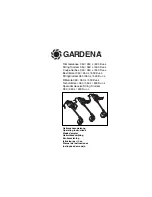
5)
Remember there is no such thing as
a “safe” slope
. Travel on grass slopes
requires particular care. To guard against
overturning:
– do not stop or start suddenly when
going up or downhill;
– engage the clutch slowly and always
keep the machine in gear, especially
when travelling downhill;
– machine speeds should be kept low on
slopes and during tight turns;
– stay alert for humps and hollows and
other hidden hazards;
–
never mow across the face of the
slope
.
6) Use care when pulling loads or using
heavy equipment:
– use only approved drawbar hitch
points;
– limit loads to those you can safely con-
trol;
– do not turn sharply. Use care when
reversing;
– use counterweight(s) or wheel weights
when suggested in the instruction hand-
book.
7) Stop the blades rotating before cross-
ing surfaces other than grass.
8)
Never operate the machine with
defective guards, or without safety pro-
tective devices in place
.
9)
Do not change the engine governor
settings or overspeed the engine
.
Operating the engine at excessive speed
can increase the hazard of personal injury.
10)
Before leaving the operator’s posi-
tion
:
– disengage the power take-off and
lower the attachments;
– change into neutral and set the parking
brake;
– stop the engine and remove the key.
11)
Disengage drive to attachments,
stop the engine and remove the igni-
tion key
:
– before clearing blockages or unclog-
ging chutes;
– before cleaning, checking or working
on the machine;
– after striking a foreign object. Inspect
the machine for damage and make
repairs before restarting and operating
the equipment;
– If the machine starts to vibrate abnor-
mally (check immediately).
12) Disengage drive to blades when
transporting or not in use.
13)
Stop the engine and disengage
drive to the attachment
:
– before refuelling;
– before removing the grass catcher.
14) Reduce the throttle setting during
engine run-out and, if the engine is pro-
vided with a shut-off valve, turn the fuel
off at the conclusion of mowing.
D) MAINTENANCE AND STORAGE
1) Keep all nuts, bolts and screws tight to
be sure the equipment is in safe working
condition.
2) Never store the equipment with petrol
in the tank inside a building where fumes
may reach an open flame or spark.
3) Allow the engine to cool before storing
in any enclosure.
4) To reduce the fire hazard, keep the
engine, silencer, battery compartment
and petrol storage area free of grass,
leaves, or excessive grease.
5) Check the grass catcher frequently for
wear or deterioration.
6)
Replace worn or damaged parts for
safety
.
7) If the fuel tank has to be drained, this
should be done outdoors.
8) On multi-bladed machines, take care
as rotating one blade can cause other
blades to rotate.
9) When the machine is to be stored or
left unattended, lower the cutting deck.
SAFETY
5
EN
Summary of Contents for TM-102.16
Page 50: ...48 DE...
Page 98: ...48 FR...
Page 146: ...48 EN...
Page 194: ...48 IT...
Page 242: ...48 ES...
















































